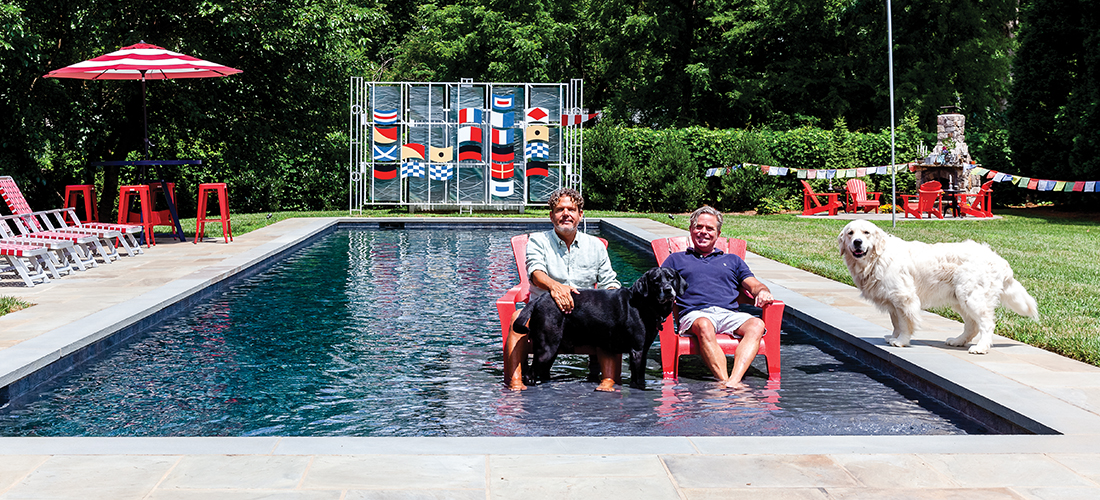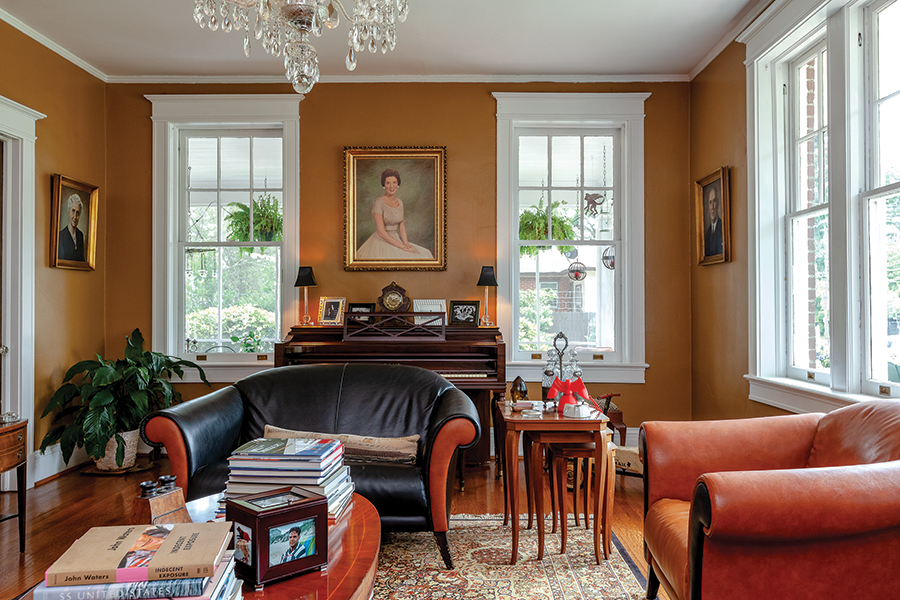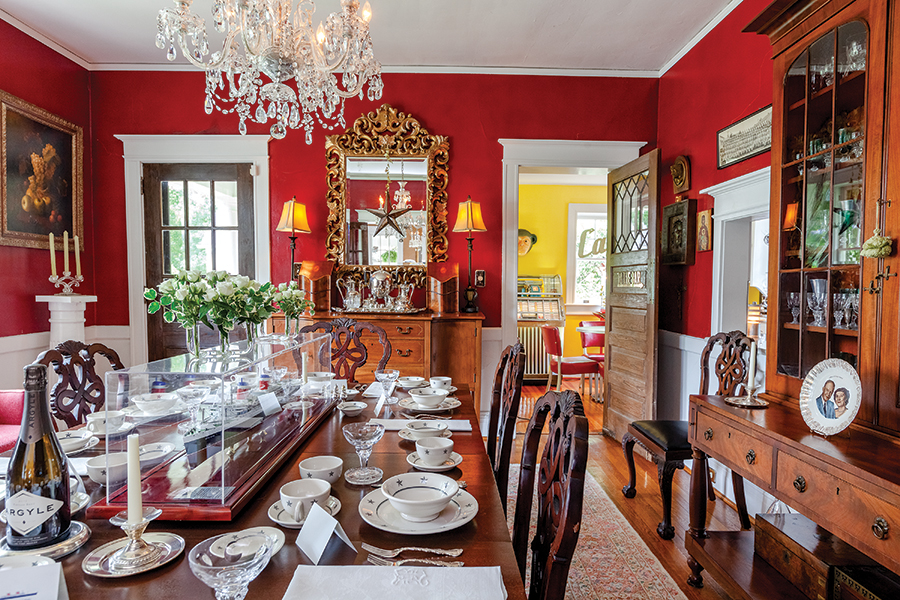
Frank Slate Brooks and Brad Newton are always ready to set sail for adventure from the comfort of their nautical-themed home in historic Lindley Park
By Billy Ingram • Photographs by John Koob Gessner
Frank Slate Brooks and Brad Newton have chosen to cruise through life, moored but not anchored to their spectacular Lindley Park home, a retro-pop sanctuary where elegance and eccentricity collide.
Frank was raised in High Point, Brad in Burlington. They’ll have been a couple for 23 years this August. “We found out a couple of years into our relationship that our grandparents had been best friends,” Frank tells me. “We don’t know if we met each other as kids or not, but it was meant to be somehow.”
If their names sound familiar, it may be due to a blizzard of publicity that erupted in 2014 after they became the first gay couple to marry in Guilford County. “I didn’t realize that the media might be there,” Frank recalls. With that in mind, their first thought was — would their parents be OK with this being public? “My father is very conservative,” Frank says. “My mother had already passed and my dad was out at River Landing. Someone had left him a copy of the newspaper next to his bed and wrote ‘Congratulations’ on it. I walked in and Dad said, ‘So what have you been up to?’ He was all good.”

And so was the community at large. “We really thought there would be some kind of backlash or something nasty but it was the opposite,” Brad says. “At the baseball stadium the Saturday after, there was a chili cookout thing going on and people of all ages were coming up to us giving us hugs, it was just great.” Frank Slate Brooks, now with Tyler Redhead & McAlister Real Estate, has sold well over 100 homes in and around Lindley Park since 2006. “In 2001, I started out flipping homes with my then partner [interior designer] Laurie Lanier,” Frank tells me. “She staged a house for me and it sold in less than half a day. We did about 12 houses here in Lindley Park before we priced ourselves out of the market because when we started, Lindley Park was not what it is today. Everything that we sold raised the prices for all the properties around them.”
After his experience flipping houses, Frank realized he needed to get his real estate license, “I really think we [Stephanie and I] were responsible for the renaissance of Lindley Park.”
Graced with tree-lined streets, eclectic architecture and neighborhood schools, Lindley Park was ripe for a revival once people began moving in from the suburbs. It was originally the site of an amusement park designed by the Greensboro Electric Company in 1902 to generate interest in the city’s new trolley line. That 3-mile trolley ride down Spring Garden from the center of town took around an hour and a half. (You could walk in half the time, but the muddy terrain wasn’t exactly pedestrian-friendly.)


Named for J. Van Lindley, whose 1,130-acre nursery and Pomona Terra Cotta Company were situated nearby, the 26-acre park opened on the Fourth of July. The pavilion featured refreshment booths, a Fairyland Casino for dancing and bowling alleys. Nearby was a manmade lake for swimming and boating in the summer, ice skating in the winter, along with a miniature railroad and a 1,000-seat theater for touring vaudeville acts, as well as some sort of local monkey act. The park’s 20 x 25–foot bathhouse still stands behind the residence at 2812 Masonic Drive.
Frank and Brad’s two-story, Colonial Revival–style home on Northridge Street was built during the first wave of swank homes developed for the Lindley Park neighborhood in 1922 after the amusement park had closed. Its construction is somewhat unusual, consisting of a brick exterior with 16 inches of insulation between the walls, the majority being more brick that keep rooms naturally warm in winter and cool in the summer. “They knew how to build houses back then,” Brad says.
At the start of the 1920s, the heart of Lindley Park was the corner of Walker and Elam and it remains so today. The first collection of unrelated businesses outside downtown was most likely Sunset Hills Shopping Center, established around 1925 on the northeast and northwest corners of the intersection, with two shops and a service station where Sticks and Stones is today. The retail area expanded in the 1930s to include a Piggly Wiggly in the space Suds & Duds currently occupies.

The Pickwick Soda Shop (now Walker’s) opened around 1943, at some point in the 1960s becoming The Pickwick bar and grill where, in the evening, newspaper folks downed Blatz on tap with college students that included Jim Clark, future Director of UNCG’s MFA Creative Writing Program. Sealing its street cred as a hippie hangout in the ’60s and ’70s, The Allman Brothers played there. As the district became more bohemian with the expansion of UNCG in the 1980s, large portions of Lindley Park began to go to seed.
In 1999, Frank had been living on Mayflower Drive for around seven years when, as he recalls, “My parents said, ‘You need to get a bigger house because we’re giving you a lot of furniture’ and I thought, ‘OK . . .’” Visiting a friend who lived on Northridge Street, “We were out on her deck,” Frank remembers. “And she said, ‘These people next door are getting ready to transfer and they’re selling their home,’ and I said, ‘What house?’ We had been over there many times and never noticed this house.”
That may be because the manse is somewhat hidden behind a canopy of shade trees even older than the home itself. Frank ventured over, knocked on the door, “A woman named Mary lived here,” he says. “She showed me the house and the backyard and I said, ‘Sold!’”


A few minutes later, “Frank called me at work,” Brad recalls. “He said ‘I found a house, we’re signing the papers tonight’ and I said, ‘Whoa, slow down.’ I’ve not even seen this house! I came over after work and kinda did the same thing: ‘Sold!’”
Frank describes the surroundings in 1999, “The Filling Station [restaurant] was still a filling station with stacks of rusty cars in front of it.” Fishbones on the corner, he says “was part of The Blind Tiger next door; they closed that off and it just sat there. Now it’s the reverse.”
“Bestway was owned by two old men,” Brad remarks. “After they sold it, it became very much like a glorified Stop & Rob, not at all what it is now. There was very little activity at the corner of Walker and Elam, I think Wild Magnolia closed right as we were moving in.”
Since then, they’ve been furnishing their home in 20th-century whimsy, a Technicolor dreamscape. For instance, in an otherwise sedate living room, a Chain Drive Irish Mail push/pull pedal cart from the 1960s adorns one corner. In the breakfast room, a papier-mâché monkey mask by Mexican artist Sergio Bustamante hangs above a pristine 1952 Seeburg Select-O-Matic 100 jukebox. “We had it restored,” Frank says. Surprisingly, filling it full of hit records was easy, he adds. “I had a listing where the owner had left hundreds of 45s behind so we switch it out all the time.” They even found a place online that prints those distinctive crimson-striped labels for the jukebox’s song selections.


Brad is a big Don Knotts fan, so a poster from The Ghost and Mr. Chicken holds a prominent spot in the kitchen, as does a collection of pins acquired by Frank’s father from the many countries he’d traveled to. It continues to grow with the couple’s own additions. “This kitchen has seen so many transformations,” Frank says. “We recently did the countertops, the upper cabinets are from Preservation Greensboro.” Just off the kitchen is another equally impressive collection: of model ships he assembled as a teenager.
But what really makes their home one-of-a-kind is an unmistakable nautical theme. Both Frank and Brad (or “Frankenbrad” as their friends fondly refer to them) share a fascination with ocean liners and enjoy luxuriating on transatlantic cruises aboard vessels like the SS Norway and RMS Queen Mary 2. Part of the allure? “I love the ability to unpack once and have everything taken care of,” Frank says. “In a lot of ways, we’re very old-fashioned,” Brad explains. “On cruise ships you still have to dress for dinner, I do enjoy that. On the Queen Mary 2, they will stop people from entering the dining room in a T-shirt and shorts.”
A Carnival Cruise won’t float their boat. “We prefer the old-school, luxury Cunard ships and Celebrity Cruises,” Frank insists. “They always have lectures and more interesting things to do than your Caribbean cruises. The spa . . . high tea is very nice, the British ships are big on trivia contests. And the disco is fun for maybe one night.”
“Frank made friends with the actress Celia Imrie (of the Bridget Jones movies) on our first Queen Mary crossing,” Brad says. “We were invited to a gay wedding on board, officiated by the Captain, and she was involved in that.” Even choppy waters won’t spoil the good times for these two. “We got chased by Hurricane Mitch last year on the [Celebrity Cruise ship] Mercury,” Frank tells me. “We dodged it the first time but then it reformed in the Atlantic and they were calling it ‘Son of a Mitch.’ The waves got so bad, everyone was tossed and thrown everywhere so all drinks were free for a day or two. We have our sea legs so it didn’t bother us; we thought it was fun.”

At an early age, Frank became infatuated with America’s Flagship, the SS United States. Now he’s North Carolina co-chairman of the SS United States Conservancy, an attempt to repurpose what was once the most elegant ship on the high seas, attracting U.S. Presidents and Hollywood stars alike from the moment of her maiden voyage in 1952. A full 100 feet longer than the RMS Titanic, the SS United States still holds the record as the fastest ocean liner to cross the Atlantic. The ship was retired in 1969.
All around the home are mementos and sumptuous details salvaged from the SS United States: ashtrays, aluminum cabin keys, towels, travel posters, its “Swimming Pool” sign in the mudroom above the back door, even blankets on the beds bear the ship’s insignia.
In the dining room are several chairs, a table lamp, and fine china place settings that also originated from the ocean liner; a scale model of the ship serves as the formal table’s centerpiece. Nearby, a grandfather clock from the 1800s chimes the hour while, mounted on another wall, is a metal sculpture of Jesus wearing a crown of thorns by Felix de Weldon who famously sculpted the Iwo Jima Memorial. “It’s bolted to the wall,” Brad says. “It’s very heavy. If it ever falls off, it’ll end up in our basement.”
Recently, FrankenBrad hosted a kick-off party here for Preservation Greensboro’s tour of Lindley Park homes. “We had a great turnout,” Brad says. “Our house was going to be on the tour, but we were out of town.”

Brad, who’s worked in marketing for Replacements, Ltd. for the past 23 years, has a love for Hollywood movies, as evidenced by the dramatic framed three-sheet posters for such cult classics as Beyond the Valley of the Dolls and Stanley Kramer’s The 5,000 Fingers of Dr. T., both of them three times larger than your typical one-sheet movie poster. “They didn’t make a whole lot of three-sheets,” Brad notes. “In fact, they are always numbered.” Pointing to an etching in the bottom left hand corner of the 5,000 Fingers poster, he says, “There were only a total of 53 of these made and this is No. 8.” A poster for Roman Polanski’s 1965 thriller Repulsion is mounted above their bed because, as Brad says, “Everyone wants to see a psychotic Catherine Deneuve whenever they walk into the bedroom, right?”
If this home reminds one of Stately Wayne Manor it shouldn’t be surprising that, just like the ’66 Batman TV show, in the den next to a red rotary telephone is a bust of William Shakespeare. Pulling back The Bard’s head reveals a switch that triggers a bookcase to slide to one side, exposing the Batpole leading down to the Batcave (sliding bookcase, Batpole and Batcave not included).
Another fitting nostalgic touch? Their screened porch, which hasn’t been glassed-in as so many are nowadays. There’s something quaint about a screened porch, especially this one with four 1950s era barbershop waiting room chairs to lounge on. Very Mayberry.

Entering their backyard, dominated by a 60-foot long pool, is a bit like walking onto the deck of a cruise ship, but considerably greener. “These silver planters are from the First Class Dining Room in the SS United States,” Frank says. A wall of nautical flags, nearly an exact replica of the one situated at the end of that fabled ocean liner’s indoor pool, spells out, ‘Come on in the water’s fine!’ The outdoor shower and deck chairs also originate from the United States.
As we relaxed on the terrace, accompanied by a symphony of chirping birds, I half expected Admiral Halsey to come floating down from the sky.
“There was a time when we were talking about buying a beach house,” Brad explains. “We thought about the upkeep, the insurance, worrying every time a storm came through, so we decided we’d turn our house into a vacation property. We love to get up on Saturday mornings, put on our bathing suits [“Or not,” Frank interjects] and it’s like we’re on vacation in our own neighborhood.”

It’s safe to say the couple’s three dogs — Rex, a 6-year-old black Lab; Dios, a 9-year old golden retriever; and Ripley, a 2-year old English Cream — enjoy the pool almost as much their owners do. Frank laughs, “When we go on vacation we have a dog sitter who is always like, ‘Oh yeah!’”
Chip Callaway did the landscaping, lining the fence line with magnolias and upright skip laurel. “Chip told us, ’The first year they sleep,’” Frank explains. “‘The second year they creep and the third year they leap.’ And that’s where we are now, the leaping stage.” A pull-down motion picture screen along an exterior wall of the garage allows for cozy movie nights. No wonder they have no intention of moving or even one day downsizing. “We’re here to stay,” Frank insists. “We love it here.”
Sold! OH
Billy Ingram is a former Hollywood movie poster artist who now enjoys exploring Greensboro’s rich history.





